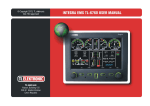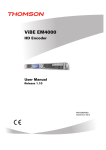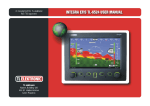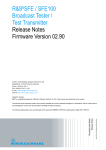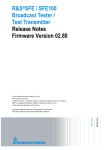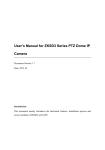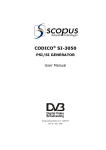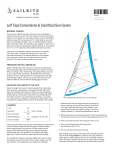Download Manual - Bay Area Aero Club
Transcript
S–TEC List of Effective Pages * Asterisk indicates pages changed, added, or deleted by current revision. Record of Revisions Retain this record in front of handbook. Upon receipt of a revision, insert changes and complete table below. Revision Number st Revision Date 1 Ed. 2nd Ed. Feb 01, 00 Jun 24, 02 3rd Ed. Feb 15, 07 3rd Ed. Feb 15, 07 Insertion Date/Initials i S–TEC Page Intentionally Blank ii 3rd Ed. Feb 15, 07 S–TEC Table of Contents Sec. 1 Pg. Overview...........................................................................................................1–1 1.1 Document Organization....................................................................1–3 1.2 Purpose..............................................................................................1–3 1.3 General Control Theory....................................................................1–3 1.4 Modes of Operation...........................................................................1–4 1.5 2 Roll Axis Control.................................................................1–4 1.4.2 Pitch Axis Control...............................................................1–4 Block Diagrams..................................................................................1–4 Pre-Flight Procedures...................................................................................2–1 2.1 2.2 3 1.4.1 Power-Up Test....................................................................................2–3 2.1.1 System Twenty.....................................................................2–3 2.1.2 System Thirty.......................................................................2–7 2.1.3 System Thirty ALT...............................................................2–13 Pre-Flight Test....................................................................................2–17 2.2.1 System Twenty.....................................................................2–17 2.2.2 System Thirty.......................................................................2–25 2.2.3 System Thirty ALT...............................................................2–35 In-Flight Procedures......................................................................................3–1 3.1 Normal Operating Procedures........................................................3–3 3.1.1 Stabilizer (ST) Mode, System Twenty / Thirty...................3–3 3.1.2 Heading (HD) Mode, System Twenty / Thirty...................3–4 3.1.3 Low Track (LO TRK) Mode, System Twenty / Thirty........3–5 3rd Ed. Feb 15, 07 iii S–TEC 3.1.4 High Track (HI TRK) Mode, System Twenty / Thirty........3–6 3.1.4.1 LOC Course Tracking........................................3–6 3.1.4.2 GPS Course Tracking........................................3–6 3.1.4.3 VOR Course Tracking........................................3–6 3.1.5 Altitude Hold (ALT HOLD) Mode, System Thirty / Thirty ALT.....3–7 3.1.5.1 System Thirty........................................................3–7 3.1.5.2 System Thirty ALT................................................3–8 3.1.6 Manual Elevator Trim Prompts, System Thirty / Thirty ALT.....3–8 3.1.6.1 System Thirty........................................................3–8 3.1.6.2 System Thirty ALT................................................3–8 3.2 Approach Procedures.......................................................................3–11 3.2.1 Straight-In LOC Approach.................................................3–11 3.2.1.1 Heading System DG..........................................3–11 3.2.1.2 Heading System HSI.........................................3–11 3.2.2 Straight-In VOR Approach.................................................3–11 3.2.2.1 Heading System DG..........................................3–11 3.2.2.2 Heading System HSI.........................................3–11 3.2.3 LOC Approach with Procedure Turn..............................3–16 3.2.3.1 Heading System DG..........................................3–16 3.2.3.2 Heading System HSI.........................................3–16 3.2.4 VOR Approach with Procedure Turn..............................3–19 3.2.4.1 Heading System DG..........................................3–19 3.2.4.2 Heading System HSI.........................................3–19 iv 3rd Ed. Feb 15, 07 S–TEC 3.3 3.4 4 5 Yaw Damper Operation....................................................................3–22 3.3.1 AUTO Mode..........................................................................3–22 3.3.2 ON Mode..............................................................................3–22 3.3.3 Yaw Damper Trim..............................................................3–22 Autopilot Disconnect ........................................................................3–23 3.4.1 System Twenty / Thirty.......................................................3–23 3.4.2 System Thirty ALT...............................................................3–23 Operating Parameters..................................................................................4–1 4.1 Roll Axis Limits..................................................................................4–3 4.2 Pitch Axis Limits.................................................................................4–3 Glossary...........................................................................................................5–1 3rd Ed. Feb 15, 07 v S–TEC List of Figures Fig. Pg. 1–1 System Twenty Block Diagram....................................................................1–5 1–2 System Thirty Block Diagram......................................................................1–6 1–3 System Thirty ALT Block Diagram...............................................................1–7 1–4 Yaw Damper Block Diagram.......................................................................1–8 2–1 AP Display, Lamps Illuminated at Power-Up (System Twenty)...............2–4 2–2 AP Display, All Lamps Extinguished (System Twenty).............................2–4 2–3 AP Display, RDY for Operation....................................................................2–5 2–4 AP Display, Turn Coordinator Failure (System Twenty)...........................2–5 2–5 AP Display, Low Voltage Flag (System Twenty).........................................2–6 2–6 AP Display, Lamps Illuminated at Power-Up (System Thirty).................2–8 2–7 AP Display, TRIM UP Lamp Extinguished (System Thirty).......................2–8 2–8 AP Display, ALT Lamp Only Illuminated (System Thirty)...........................2–9 2–9 AP Display, All Lamps Extinguished (System Thirty)................................2–9 2–10 AP Display, RDY for Operation (System Thirty).......................................2–10 2–11 AP Display, Turn Coordinator Failure (System Thirty)............................2–10 2–12 AP Display, Low Voltage Flag (System Thirty).........................................2–11 2–13 ALT HOLD ON/OFF Switch Display, Lamps Illuminated at Power-Up (System Thirty ALT)....2–14 2–14 ALT HOLD ON/OFF Switch Display, UP Lamp Extinguished (System Thirty ALT)...............2–14 2–15 ALT HOLD ON/OFF Switch Display, DN Lamp Extinguished (System Thirty ALT)..............2–15 2–16 ALT HOLD ON/OFF Switch Display, ALT ON Lamp Extinguished (System Thirty ALT).........2–15 2–17 AP Display, ST Mode Engaged (System Twenty)....................................2–19 2–18 AP Display, HD Mode Engaged (System Twenty)...................................2–19 2–19 AP Display, LO TRK Mode Engaged (System Twenty)...........................2–21 vi 3rd Ed. Feb 15, 07 S–TEC 2–20 AP Display, HI TRK Mode Engaged (System Twenty)...........................2–21 2–21 AP Display, ST Mode Engaged (System Thirty).......................................2–27 2–22 AP Display, HD Mode Engaged (System Thirty)......................................2–27 2–23 AP Display, LO TRK Mode Engaged (System Thirty)..............................2–29 2–24 AP Display, LO TRK Mode Engaged (System Thirty)..............................2–29 2–25 AP Display, HI TRK and ALT HOLD Modes Engaged (System Thirty)........2–31 2–26 AP Display, HI TRK and ALT HOLD ModeS Engaged, TRIM UP Required (System Thirty).....2–32 2–27 AP Display, HI TRK and ALT HOLD ModeS Engaged, TRIM DN Required (System Thirty).....2–32 2–28 ALT HOLD ON/OFF Switch Display, ALT HOLD Mode Engaged (System Thirty ALT).......2–36 2–29 ALT HOLD ON/OFF Switch Display, ALT HOLD Mode Engaged, TRIM UP Required (System Thirty ALT).....2–36 2–30 ALT HOLD ON/OFF Switch Display, ALT HOLD Mode Engaged, TRIM DN Required (System Thirty ALT).....2–36 3–1 AP Display, ST Mode Engaged....................................................................3–3 3–2 AP Display, HD Mode Engaged...................................................................3–4 3–3 AP Display, LO TRK Mode Engaged...........................................................3–5 3–4 AP Display, HI TRK Mode Engaged............................................................3–6 3–5 AP Display, ST and ALT HOLD Modes Engaged (System Thirty)............3–7 3–6 ALT HOLD ON/OFF Switch Display, ALT HOLD Mode Engaged (System Thirty ALT)............3–8 3–7 AP Display, Manual Trim Prompts (System Thirty)...................................3–9 3–8 AP Display, Manual Trim Prompts (System Thirty ALT)..........................3–10 3–9 Straight-In LOC Approach (DG)..................................................................3–12 3–10 Straight-In LOC Approach (HSI)..................................................................3–13 3–11 Straight-In VOR Approach (DG)..................................................................3–14 3–12 Straight-In VOR Approach (HSI)..................................................................3–15 3–13 LOC Approach with Procedure Turn (DG)................................................3–17 3rd Ed. Feb 15, 07 vii S–TEC 3–14 LOC Approach with Procedure Turn (HSI)...............................................3–18 3–15 VOR Approach with Procedure Turn (DG)................................................3–20 3–16 VOR Approach with Procedure Turn (HSI)...............................................3–21 3–17 Yaw Damper Master Switch........................................................................3–22 3–18 Yaw Damper Trim Knob..............................................................................3–22 List of Tables Table Pg. 2–1 Power-Up Test, System Twenty...................................................................2–3 2–2 Power-Up Test, System Thirty.....................................................................2–7 2–3 Power-Up Test, System Thirty ALT.............................................................2–13 2–4 Pre-Flight Test, System Twenty...................................................................2–17 2–5 Pre-Flight Test, System Thirty.....................................................................2–25 2–6 Pre-Flight Test, System Thirty ALT.............................................................2–35 viii 3rd Ed. Feb 15, 07 S–TEC SECTION 1 OVERVIEW 3rd Ed. Feb 15, 07 1-1 S–TEC Page Intentionally Blank 1-2 3rd Ed. Feb 15, 07 S–TEC 1.1 Document Organization Section 1 Overview Section 2 Pre-Flight Procedures Section 3 In-Flight Procedures Section 4 Operating Parameters Section 5 Glossary 1.2 Purpose This Pilot's Operating Handbook (POH) provides Pre-Flight and In-Flight operating procedures for the S-TEC System Twenty / Thirty / Thirty ALT Autopilot (AP). Note: This POH must be carried in the aircraft and made available to the pilot at all times. It can only be used in conjunction with the Federal Aviation Administration (FAA) approved Aircraft Flight Manual (AFM) or Aircraft Flight Manual Supplement (AFMS). Refer to the applicable AFM or AFMS for aircraft specific information, such as unique ground tests, limitations, and emergency procedures. Note: The System Twenty / Thirty / Thirty ALT autopilot is a tool provided to aircraft owners, that serves to assist them with cockpit workload management. The ability of the autopilot to provide optimum assistance and performance is directly proportional to the pilot's knowledge of its operating procedures. Therefore, it is highly recommended that the pilot develop a thorough understanding of the autopilot, its modes, and operating procedures in Visual Meteorological Conditions (VMC), prior to using it under Instrument Flight Rules (IFR). 1.3 General Control Theory The System Twenty / Thirty / Thirty ALT is a rate based autopilot. When in control of the roll axis, the autopilot senses turn rate, along with the non-rate quantities of heading error and course deviation indication. When in control of the pitch axis, the autopilot senses acceleration, along with the non-rate quantity of altitude. These sensed data provide feedback to the autopilot, which processes them in order to control the aircraft through the use of mechanisms coupled to the control system. The roll servo is typically coupled to the ailerons, and the pitch servo is coupled to the elevator. The System Twenty controls only the roll axis. The System Thirty controls both the roll axis and pitch axis. Activation of roll axis control must always precede activation of pitch axis control. The System Thirty ALT controls only the pitch axis. 3rd Ed. Feb 15, 07 1-3 S–TEC The optional Yaw Damper senses excessive adverse yaw about the yaw axis, and responds by driving the yaw servo in the proper direction to provide damping. The yaw servo is coupled to the rudder. 1.4 Modes of Operation 1.4.1 Roll Axis Control Each press/release of the optional MODE SEL Switch typically located on the Control Wheel, or PUSH MODE Switch located on the bezel, successively engages the roll modes below. Stabilizer (ST) Mode Used to Hold Wings Level Heading (HD) Mode Used to Turn onto a Selected Heading and Hold it Low Track (LO TRK) Mode Used to Track a VOR Course High Track (HI TRK) Mode Used to Track a LOC Course Note: A heading system (HSI or DG) is optional. If the aircraft is equipped with a heading system, then the heading mode can be engaged. Otherwise, the heading mode cannot be engaged (i.e., it will be skipped over). 1.4.2 Pitch Axis Control Each press of the ALT ENG/DSNG Switch typically located on the Control Wheel (optional for System Thirty ALT only), or ALT HOLD ON/OFF Switch located on the instrument panel (System Thirty ALT only), successively engages and disengages the single pitch mode below. Altitude Hold (ALT HOLD) Mode Used to Hold Altitude 1.5 Block Diagrams The System Twenty Block Diagram is shown in Fig. 1-1. The System Thirty Block Diagram is shown in Fig. 1-2. The System Thirty ALT Block Diagram is shown in Fig. 1-3. The Yaw Damper Block Diagram is shown in Fig. 1-4. 1-4 3rd Ed. Feb 15, 07 S–TEC Fig. 1-1. System Twenty Block Diagram 3rd Ed. Feb 15, 07 1-5 S–TEC Fig. 1-2. System Thirty Block Diagram 1-6 3rd Ed. Feb 15, 07 S–TEC Fig. 1-3. System Thirty ALT Block Diagram 3rd Ed. Feb 15, 07 1-7 S–TEC Fig. 1-4. Yaw Damper Block Diagram 1-8 3rd Ed. Feb 15, 07 S–TEC SECTION 2 PRE-FLIGHT PROCEDURES 3rd Ed. Feb 15, 07 2-1 S–TEC Page Intentionally Blank 2-2 3rd Ed. Feb 15, 07 S–TEC 2.1 Power-Up Test 2.1.1 System Twenty Perform the actions shown in Table 2-1. For each action, verify the corresponding response where applicable. Table 2-1. Power-Up Test, System Twenty ACTION RESPONSE 1. Set Yaw Damper Master Switch to OFF position (if installed). ------ 2. Set Battery Master Switch to ON position. ------ 3. Set Avionics Master Switch to ON position. ------ 4. Set Autopilot Master Switch to ON position. RDY, ST, HD, LO TRK, and HI TRK lamps illuminate on AP display as shown in Fig. 2-1 for 7 seconds, and then extinguish as shown in Fig. 2-2. RDY lamp alone re-illuminates on AP display within 3 minutes, as shown in Fig. 2-3 (Note 1). Notes: 1. Should a Turn Coordinator failure be detected, the RDY lamp on the AP display will not re-illuminate as shown in Fig. 2-4, and the autopilot will not operate. 2. Should T&B A+ be 30% below its rated value, the Low Voltage Flag will be in view on the AP display as shown in Fig. 2-5. 3rd Ed. Feb 15, 07 2-3 S–TEC Fig. 2-1. AP Display, RDY, ST, HD, LO TRK, HI TRK Lamps Illuminated at Power-Up (System Twenty) Fig. 2-2. AP Display, All Lamps Extinguished (System Twenty) 2-4 3rd Ed. Feb 15, 07 S–TEC Fig. 2-3. AP Display, RDY for Operation (System Twenty) Fig. 2-4. AP Display, Turn Coordinator Failure (System Twenty) 3rd Ed. Feb 15, 07 2-5 S–TEC Fig. 2-5. AP Display, Low Voltage Flag (System Twenty) 2-6 3rd Ed. Feb 15, 07 S–TEC 2.1.2 System Thirty Perform the actions shown in Table 2-2. For each action, verify the corresponding response where applicable. Table 2-2. Power-Up Test, System Thirty ACTION RESPONSE 1. Set Yaw Damper Master Switch to OFF position (if installed). ------ 2. Set Battery Master Switch to ON position. ------ 3. Set Avionics Master Switch to ON position. ------ 4. Set Autopilot Master Switch to ON position. RDY, ALT, ST, HD, LO TRK, HI TRK, TRIM UP, and TRIM DN lamps illuminate on AP display as shown in Fig. 2-6. TRIM UP lamp extinguishes after 2 seconds, as shown in Fig. 2-7. RDY, ST, HD, LO TRK, HI TRK, and TRIM DN lamps extinguish after 7 seconds, as shown in Fig. 2-8. ALT lamp extinguishes after 10 seconds, as shown in Fig. 2-9. RDY lamp alone re-illuminates on AP display within 3 minutes, as shown in Fig. 2-10 (Note 1). Notes: 1. Should a Turn Coordinator failure be detected, the RDY lamp on the AP display will not re-illuminate as shown in Fig. 2-11, and the autopilot will not operate. 2. Should T&B A+ be 30% below its rated value, the Low Voltage Flag will be in view on the AP display as shown in Fig. 2-12. 3rd Ed. Feb 15, 07 2-7 S–TEC Fig. 2-6. AP Display, RDY, ALT, ST, HD, LO TRK, HI TRK, TRIM UP, TRIM DN Lamps Illuminated at Power-Up (System Thirty) Fig. 2-7. AP Display, TRIM UP Lamp Extinguished (System Thirty) 2-8 3rd Ed. Feb 15, 07 S–TEC Fig. 2-8. AP Display, ALT Lamp Only Illuminated (System Thirty) Fig. 2-9. AP Display, All Lamps Extinguished (System Thirty) 3rd Ed. Feb 15, 07 2-9 S–TEC Fig. 2-10. AP Display, RDY for Operation (System Thirty) Fig. 2-11. AP Display, Turn Coordinator Failure (System Thirty) 2-10 3rd Ed. Feb 15, 07 S–TEC Fig. 2-12. AP Display, Low Voltage Flag (System Thirty) 3rd Ed. Feb 15, 07 2-11 S–TEC Page Intentionally Blank 2-12 3rd Ed. Feb 15, 07 S–TEC 2.1.3 System Thirty ALT Perform the actions shown in Table 2-3. For each action, verify the corresponding response where applicable. Table 2-3. Power-Up Test, System Thirty ALT ACTION RESPONSE 1. Set Yaw Damper Master Switch to OFF position (if installed). ------ 2. Set Battery Master Switch to ON position. ------ 3. Set Avionics Master Switch to ON position. ------ 4. Set ALT HOLD Master Switch to ON position. ALT ON, UP, and DN lamps illuminate on ALT HOLD ON/OFF Switch display, as shown in Fig. 2-13. UP lamp extinguishes after 2 seconds, as shown in Fig. 2-14. DN lamp extinguishes after 7 seconds, as shown in Fig. 2-15. ALT ON lamp extinguishes after 10 seconds, as shown in Fig. 2-16. 3rd Ed. Feb 15, 07 2-13 S–TEC Fig. 2-13. ALT HOLD ON/OFF Switch Display, ALT ON, UP, and DN Lamps Illuminated at Power-Up (System Thirty ALT) Fig. 2-14. ALT HOLD ON/OFF Switch Display, UP Lamp Extinguished (System Thirty ALT) 2-14 3rd Ed. Feb 15, 07 S–TEC Fig. 2-15. ALT HOLD ON/OFF Switch Display, DN Lamp Extinguished (System Thirty ALT) Fig. 2-16. ALT HOLD ON/OFF Switch Display, ALT ON Lamp Extinguished (System Thirty ALT) 3rd Ed. Feb 15, 07 2-15 S–TEC Page Intentionally Blank 2-16 3rd Ed. Feb 15, 07 S–TEC 2.2 Pre-Flight Test 2.2.1 System Twenty Prior to takeoff and with engine running, perform the actions shown in Table 2-4. For each action, verify the corresponding response where applicable. Table 2-4. Pre-Flight Test, System Twenty (continued on page 2-18) ACTION RESPONSE 1. Move A/C Control Wheel left and right, to sense its freedom of movement about roll axis. ------ 2. Set L/R Turn Knob located on bezel under its index. ------ 3. Engage stabilizer mode. ST lamp alone is illuminated on AP display, as shown in Fig. 2-17. 4. Attempt movement of A/C Control Wheel left and right. A/C Control Wheel’s reduced freedom of movement indicates that Roll Servo is engaged. Roll Servo can be overridden. If not, disconnect autopilot and do not use. 5. Turn L/R Turn Knob to the left side of its index. A/C Control Wheel turns to the left. 6. Turn L/R Turn Knob to the right side of its index. A/C Control Wheel turns to the right. 7. Set L/R Turn Knob under its index. A/C Control Wheel stops. Note: If A/C is equipped with a heading system (HSI or DG), then proceed to step 8. If A/C is not equipped with a heading system, then proceed to step 13 only if a VOR frequency can be selected. Otherwise, proceed to step 26. 3rd Ed. Feb 15, 07 2-17 S–TEC Table 2-4. Pre-Flight Test, System Twenty (continued from page 2-17) ACTION RESPONSE 8. Set Heading Bug under Lubber Line. ------ 9. Engage heading mode. HD lamp alone is illuminated on AP display, as shown in Fig. 2-18. 10. Turn Heading Bug to the left side of Lubber Line. A/C Control Wheel turns to the left. 11. Turn Heading Bug to the right side of Lubber Line. A/C Control Wheel turns to the right. 12. Set Heading Bug under Lubber Line. A/C Control Wheel stops. Note: If it is not possible to select a local VOR frequency on Navigation Receiver, then proceed to step 26. Otherwise, proceed to step 13. 13. Select local VOR frequency on Navigation Receiver. ------ Note: Proceed to either step 14 (HSI) or step 20 (DG). 14. Turn Course Pointer until CDI needle is centered. ------ 15. Engage low track mode. LO TRK lamp alone is illuminated on AP display, as shown in Fig. 2-19. 16. Engage high track mode. HI TRK lamp alone is illuminated on AP display, as shown in Fig. 2-20. 17. Turn Course Pointer left until CDI needle deflection is 2 dots right of center. A/C Control Wheel turns to the right. 2-18 3rd Ed. Feb 15, 07 S–TEC Fig. 2-17. AP Display, ST Mode Engaged (System Twenty) Fig. 2-18. AP Display, HD Mode Engaged (System Twenty) 3rd Ed. Feb 15, 07 2-19 S–TEC Table 2-4. Pre-Flight Test, System Twenty (continued from page 2-18) ACTION RESPONSE 18. Turn Course Pointer right until CDI needle deflection is 2 dots left of center. A/C Control Wheel turns to the left. 19. Turn Course Pointer left until CDI needle is centered. A/C Control Wheel stops. Note: Proceed to step 28. 20. Turn OBS until CDI needle is centered. ------ 21. Engage low track mode. LO TRK lamp alone is illuminated on AP display, as shown in Fig. 2-19. 22. Engage high track mode. HI TRK lamp alone is illuminated on AP display, as shown in Fig. 2-20. 23. Turn OBS until CDI needle deflection is 2 dots right of center. A/C Control Wheel turns to the right. 24. Turn OBS until CDI needle deflection is 2 dots left of center. A/C Control Wheel turns to the left. 25. Turn OBS until CDI needle is centered. A/C Control Wheel stops. Note: Proceed to step 28. 26. Engage low track mode. LO TRK lamp alone is illuminated on AP display, as shown in Fig. 2-19. 27. Engage high track mode. HI TRK lamp alone is illuminated on AP display, as shown in Fig. 2-20. 2-20 3rd Ed. Feb 15, 07 S–TEC Fig. 2-19. AP Display, LO TRK Mode Engaged (System Twenty) Fig. 2-20. AP Display, HI TRK Mode Engaged (System Twenty) 3rd Ed. Feb 15, 07 2-21 S–TEC Table 2-4. Pre-Flight Test, System Twenty (continued from page 2-20) ACTION RESPONSE 28. Disconnect autopilot by any one of the following means: RDY lamp flashes and audible alert sounds a periodic tone, while all other lamps are extinguished. a. Press optional AP DISC Switch typically located on Control Wheel. b. Press/Hold optional MODE SEL Switch typically located on Control Wheel for 3 seconds. After 5 seconds, RDY lamp stops flashing but remains illuminated, and audible alert is squelched. c. Press/Hold PUSH MODE Switch located on bezel for 3 seconds. 29. Move A/C Control Wheel left and right. A/C Control Wheel’s increased freedom of movement indicates that Roll Servo is disengaged. Note: If a Yaw Damper is installed, then proceed to step 30. proceed to step 39. Otherwise, 30. Actuate A/C Rudder Pedals alternately in succession, to sense their freedom of movement about yaw axis. ------ 31. Set Yaw Damper Master Switch to ON position. ------ 32. Turn Yaw Trim Knob until A/C Rudder Pedals stop. ------ 33. Attempt actuation of A/C Rudder Pedals alternately in succession. A/C Rudder Pedals’ reduced freedom of movement indicates that Yaw Servo is engaged. Yaw Servo can be overridden. If not, set Yaw Damper Master Switch to OFF position, and do not use. 2-22 3rd Ed. Feb 15, 07 S–TEC Table 2-4. Pre-Flight Test, System Twenty (continued from page 2-22) ACTION RESPONSE 34. Turn Yaw Trim Knob fully CCW. Left A/C Rudder Pedal slowly moves forward. 35. Turn Yaw Trim Knob fully CW. Right A/C Rudder moves forward. 36. Turn Yaw Trim Knob CCW until A/C Rudder Pedals stop. ------ 37. Set Yaw Damper Master Switch to OFF position. ------ 38. Actuate A/C Rudder alternately in succession. 39. Trim A/C for takeoff. 3rd Ed. Feb 15, 07 Pedals Pedal slowly A/C Rudder Pedals’ increased freedom of movement indicates that Yaw Servo is disengaged. ------ 2-23 S–TEC Page Intentionally Blank 2-24 3rd Ed. Feb 15, 07 S–TEC 2.2.2 System Thirty Prior to takeoff and with engine running, perform the actions shown in Table 2-5. For each action, verify the corresponding response where applicable. Table 2-5. Pre-Flight Test, System Thirty (continued on page 2-26) ACTION RESPONSE 1. Move A/C Control Wheel left and right, to sense its freedom of movement about roll axis. ------ 2. Set L/R Turn Knob located on bezel under its index. ------ 3. Engage stabilizer mode. ST lamp alone is illuminated on AP display, as shown in Fig. 2-21. 4. Attempt movement of A/C Control Wheel left and right. A/C Control Wheel’s reduced freedom of movement indicates that Roll Servo is engaged. Roll Servo can be overridden. If not, disconnect autopilot and do not use. 5. Turn L/R Turn Knob to the left side of its index. A/C Control Wheel turns to the left. 6. Turn L/R Turn Knob to the right side of its index. A/C Control Wheel turns to the right. 7. Set L/R Turn Knob under its index. A/C Control Wheel stops. Note: If A/C is equipped with a heading system (HSI or DG), then proceed to step 8. If A/C is not equipped with a heading system, then proceed to step 13 only if a VOR frequency can be selected. Otherwise, proceed to step 26. 3rd Ed. Feb 15, 07 2-25 S–TEC Table 2-5. Pre-Flight Test, System Thirty (continued from page 2-25) ACTION RESPONSE 8. Set Heading Bug under Lubber Line. ------ 9. Engage heading mode. HD lamp alone is illuminated on AP display, as shown in Fig. 2-22. 10. Turn Heading Bug to the left side of Lubber Line. A/C Control Wheel turns to the left. 11. Turn Heading Bug to the right side of Lubber Line. A/C Control Wheel turns to the right. 12. Set Heading Bug under Lubber Line. A/C Control Wheel stops. Note: If it is not possible to select a local VOR frequency on Navigation Receiver, then proceed to step 26. Otherwise, proceed to step 13. 13. Select local VOR frequency on Navigation Receiver. ------ Note: Proceed to either step 14 (HSI) or step 20 (DG). 14. Turn Course Pointer until CDI needle is centered. ------ 15. Engage low track mode. LO TRK lamp alone is illuminated on AP display, as shown in Fig. 2-23. 16. Engage high track mode. HI TRK lamp alone is illuminated on AP display, as shown in Fig. 2-24. 17. Turn Course Pointer left until CDI needle deflection is 2 dots right of center. A/C Control Wheel turns to the right. 2-26 3rd Ed. Feb 15, 07 S–TEC Fig. 2-21. AP Display, ST Mode Engaged (System Thirty) Fig. 2-22. AP Display, HD Mode Engaged (System Thirty) 3rd Ed. Feb 15, 07 2-27 S–TEC Table 2-5. Pre-Flight Test, System Thirty (continued from page 2-26) ACTION RESPONSE 18. Turn Course Pointer right until CDI needle deflection is 2 dots left of center. A/C Control Wheel turns to the left. 19. Turn Course Pointer left until CDI needle is centered. A/C Control Wheel stops. Note: Proceed to step 28. 20. Turn OBS until CDI needle is centered. ------ 21. Engage low track mode. LO TRK lamp alone is illuminated on AP display, as shown in Fig. 2-23. 22. Engage high track mode. HI TRK lamp alone is illuminated on AP display, as shown in Fig. 2-24. 23. Turn OBS until CDI needle deflection is 2 dots right of center. A/C Control Wheel turns to the right. 24. Turn OBS until CDI needle deflection is 2 dots left of center. A/C Control Wheel turns to the left. 25. Turn OBS until CDI needle is centered. A/C Control Wheel stops. Note: Proceed to step 28. 26. Engage low track mode. LO TRK lamp alone is illuminated on AP display, as shown in Fig. 2-23. 27. Engage high track mode. HI TRK lamp alone is illuminated on AP display, as shown in Fig. 2-24. 2-28 3rd Ed. Feb 15, 07 S–TEC Fig. 2-23. AP Display, LO TRK Mode Engaged (System Thirty) Fig. 2-24. AP Display, HI TRK Mode Engaged (System Thirty) 3rd Ed. Feb 15, 07 2-29 S–TEC Table 2-5. Pre-Flight Test, System Thirty (continued from page 2-28) ACTION RESPONSE 28. Move A/C Control Wheel forward and aft, to sense its freedom of movement about pitch axis. ------ 29. Engage altitude hold mode. 30. Attempt movement of Control Wheel forward and aft. ALT lamp is illuminated on AP display, as shown in Fig. 2-25. A/C A/C Control Wheel’s reduced freedom of movement indicates that Pitch Servo is engaged. Pitch Servo can be overridden. If not, disconnect autopilot and do not use. 31. Move A/C Control Wheel as far forward as possible. After 3 seconds, TRIM UP lamp becomes illuminated on AP display as shown in Fig. 2-26, and audible alert sounds a steady tone. After 7 seconds, TRIM UP lamp flashes and audible alert becomes periodic. 32. Move A/C Control Wheel aft until TRIM UP lamp is extinguished. Audible alert is squelched. 33. Move A/C Control Wheel as far aft as possible. After 3 seconds, TRIM DN lamp becomes illuminated on AP display as shown in Fig. 2-27, and audible alert sounds a steady tone. After 7 seconds, TRIM DN lamp flashes and audible alert becomes periodic. 34. Move A/C Control Wheel forward until TRIM DN lamp is extinguished. 2-30 Audible alert is squelched. 3rd Ed. Feb 15, 07 S–TEC Fig. 2-25. AP Display, HI TRK and ALT HOLD Modes Engaged (System Thirty) 3rd Ed. Feb 15, 07 2-31 S–TEC Fig. 2-26. AP Display, HI TRK and ALT HOLD Modes Engaged, TRIM UP Required (System Thirty) Fig. 2-27. AP Display, HI TRK and ALT HOLD Modes Engaged, TRIM DN Required (System Thirty) 2-32 3rd Ed. Feb 15, 07 S–TEC Table 2-5. Pre-Flight Test, System Thirty (continued from page 2-30) ACTION RESPONSE 35. Disconnect autopilot by any one of the following means: RDY lamp flashes and audible alert sounds a periodic tone, while all other lamps are extinguished. a. Press optional AP DISC Switch typically located on Control Wheel. b. Press/Hold optional MODE SEL Switch typically located on Control Wheel for 3 seconds. After 5 seconds, RDY lamp stops flashing but remains illuminated, and audible alert is squelched. c. Press/Hold PUSH MODE Switch located on bezel for 3 seconds. 36. Move A/C Control Wheel left and right. A/C Control Wheel’s increased freedom of movement indicates that Roll Servo is disengaged. 37. Move A/C Control Wheel forward and aft. A/C Control Wheel’s increased freedom of movement indicates that Pitch Servo is disengaged. Note: If a Yaw Damper is installed, then proceed to step 38. proceed to step 47. 38. Actuate A/C Rudder Pedals alternately in succession, to sense their freedom of movement about yaw axis. ------ 39. Set Yaw Damper Master Switch to ON position. ------ 40. Turn Yaw Trim Knob until A/C Rudder Pedals stop. ------ 3rd Ed. Feb 15, 07 Otherwise, 2-33 S–TEC Table 2-5. Pre-Flight Test, System Thirty (continued from page 2-33) ACTION RESPONSE 41. Attempt actuation of A/C Rudder Pedals alternately in succession. A/C Rudder Pedals’ reduced freedom of movement indicates that Yaw Servo is engaged. Yaw Servo can be overridden. If not, set Yaw Damper Master Switch to OFF position, and do not use. 42. Turn Yaw Trim Knob fully CCW. Left A/C Rudder Pedal slowly moves forward. 43. Turn Yaw Trim Knob fully CW. Right A/C Rudder moves forward. 44. Turn Yaw Trim Knob CCW until A/C Rudder Pedals stop. ------ 45. Set Yaw Damper Master Switch to OFF position. ------ 46. Actuate A/C Rudder alternately in succession. 47. Trim A/C for takeoff. 2-34 Pedals Pedal slowly A/C Rudder Pedals’ increased freedom of movement indicates that Yaw Servo is disengaged. ------ 3rd Ed. Feb 15, 07 S–TEC 2.2.3 System Thirty ALT Prior to takeoff and with engine running, perform the actions shown in Table 2-6. For each action, verify the corresponding response where applicable. Table 2-6. Pre-Flight Test, System Thirty ALT (continued on page 2-37) ACTION RESPONSE 1. Move A/C Control Wheel forward and aft, to sense its freedom of movement about pitch axis. ------ 2. Engage altitude hold mode. ALT ON lamp is illuminated on ALT HOLD ON/OFF Switch display, as shown in Fig. 2-28. 3. Attempt movement of A/C Control Wheel forward and aft. A/C Control Wheel’s reduced freedom of movement indicates that Pitch Servo is engaged. Pitch Servo can be overridden. If not, disconnect autopilot and do not use. 4. Move A/C Control Wheel as far forward as possible. After 3 seconds, UP lamp becomes illuminated on ALT HOLD ON/OFF Switch display as shown in Fig. 2-29, and audible alert sounds a steady tone. After 7 seconds, UP lamp flashes and audible alert becomes periodic. 5. Move A/C Control Wheel aft until UP lamp is extinguished. Audible alert is squelched. 6. Move A/C Control Wheel as far aft as possible. After 3 seconds, DN lamp becomes illuminated on ALT HOLD ON/OFF Switch display as shown in Fig. 2-30, and audible alert sounds a steady tone. After 7 seconds, DN lamp flashes and audible alert becomes periodic. 3rd Ed. Feb 15, 07 2-35 S–TEC Fig. 2-28. ALT HOLD ON/OFF Switch Display, ALT HOLD Mode Engaged (System Thirty ALT) Fig. 2-29. ALT HOLD ON/OFF Switch Display, ALT HOLD Mode Engaged, TRIM UP Required (System Thirty ALT) Fig. 2-30. ALT HOLD ON/OFF Switch Display, ALT HOLD Mode Engaged, TRIM DN Required (System Thirty ALT) 2-36 3rd Ed. Feb 15, 07 S–TEC Table 2-6. Pre-Flight Test, System Thirty ALT (continued from page 2-35) ACTION RESPONSE 7. Move A/C Control Wheel forward until DN lamp is extinguished. Audible alert is squelched. 8. Disengage altitude hold mode. ALT ON lamp is extinguished on ALT HOLD ON/OFF Switch display. 9. Move A/C Control Wheel forward and aft. A/C Control Wheel’s increased freedom of movement indicates that Pitch Servo is disengaged. Note: If a Yaw Damper is installed, then proceed to step 10. proceed to step 19. Otherwise, 10. Actuate A/C Rudder Pedals alternately in succession, to sense their freedom of movement about yaw axis. ------ 11. Set Yaw Damper Master Switch to ON position. ------ 12. Turn Yaw Trim Knob until A/C Rudder Pedals stop. ------ 13. Attempt actuation of A/C Rudder Pedals alternately in succession. A/C Rudder Pedals’ reduced freedom of movement indicates that Yaw Servo is engaged. Yaw Servo can be overridden. If not, set Yaw Damper Master Switch to OFF position, and do not use. 14. Turn Yaw Trim Knob fully CCW. Left A/C Rudder Pedal slowly moves forward. 15. Turn Yaw Trim Knob fully CW. Right A/C Rudder moves forward. 3rd Ed. Feb 15, 07 Pedal slowly 2-37 S–TEC Table 2-5. Pre-Flight Test, System Thirty ALT (continued from page 2-37) ACTION RESPONSE 16. Turn Yaw Trim Knob CCW until A/C Rudder Pedals stop. ------ 17. Set Yaw Damper Master Switch to OFF position. ------ 18. Actuate A/C Rudder alternately in succession. 19. Trim A/C for takeoff. 2-38 Pedals A/C Rudder Pedals’ increased freedom of movement indicates that Yaw Servo is disengaged. ------ 3rd Ed. Feb 15, 07 S–TEC SECTION 3 IN-FLIGHT PROCEDURES 3rd Ed. Feb 15, 07 3-1 S–TEC Page Intentionally Blank 3-2 3rd Ed. Feb 15, 07 S–TEC 3.1 Normal Operating Procedures 3.1.1 Stabilizer (ST) Mode, System Twenty / Thirty Set the L/R Turn Knob under its index, and then engage the stabilizer mode. The ST lamp alone will be illuminated as shown in Fig. 3-1, to acknowledge that this mode is engaged. The autopilot will hold the aircraft at wings level. Turning the L/R Turn Knob to the left or right of its index will cause the aircraft to turn either left or right, respectively. The L/R Turn Knob is active only when the stabilizer mode is engaged. Fig. 3-1. AP Display, ST Mode Engaged 3rd Ed. Feb 15, 07 3-3 S–TEC 3.1.2 Heading (HD) Mode, System Twenty / Thirty Set the Heading Bug to the desired heading on the compass card (HSI or DG), and then engage the heading mode. The HD lamp alone will be illuminated as shown in Fig. 3-2, to acknowledge that this mode is engaged. The autopilot will turn the aircraft onto the selected heading and hold it. A new heading can be subsequently selected by setting the Heading Bug to it. Fig. 3-2. AP Display, HD Mode Engaged 3-4 3rd Ed. Feb 15, 07 S–TEC 3.1.3 Low Track (LO TRK) Mode, System Twenty / Thirty Select the VOR frequency on the Navigation Receiver. Maneuver the aircraft to within ±1 CDI needle width and ±10° heading of the selected course. Engage the low track mode. The LO TRK lamp alone will be illuminated as shown in Fig. 3-3, to acknowledge that this mode is engaged. The autopilot will track the selected course with minimum authority, thereby ignoring short term CDI needle deflections (excursions) to inhibit aircraft scalloping during VOR station passage. Fig. 3-3. AP Display, LO TRK Mode Engaged 3rd Ed. Feb 15, 07 3-5 S–TEC 3.1.4 High Track (HI TRK) Mode, System Twenty / Thirty 3.1.4.1 LOC Course Tracking Select the LOC frequency on the Navigation Receiver. Maneuver the aircraft to within ±1 CDI needle width and ±10° heading of the selected course. Engage the high track mode. The HI TRK lamp alone will be illuminated as shown in Fig. 3-4, to acknowledge that this mode is engaged. The autopilot will track the selected course with maximum authority. 3.1.4.2 GPS Course Tracking Program a predefined course into the GPS Navigation Receiver, comprised of course segments connected by waypoints. Maneuver the aircraft to within ±1 CDI needle width and ±10° heading of each successive course segment. Engage the high track mode. The HI TRK lamp alone will be illuminated as shown in Fig. 3-4, to acknowledge that this mode is engaged. The autopilot will track the selected course segment with maximum authority. 3.1.4.3 VOR Course Tracking Select the VOR frequency on the Navigation Receiver. Maneuver the aircraft to within ±1 CDI needle width and ±10° heading of the selected course. Engage the high track mode. The HI TRK lamp alone will be illuminated as shown in Fig. 3-4, to acknowledge that this mode is engaged. The autopilot will track the selected course with maximum authority. As a result, however, the aircraft may exhibit scalloping during VOR station passage. Fig. 3-4. AP Display, HI TRK Mode Engaged 3-6 3rd Ed. Feb 15, 07 S–TEC 3.1.5 Altitude Hold (ALT HOLD) Mode, System Thirty / Thirty ALT 3.1.5.1 System Thirty The altitude hold mode can only be engaged if a roll mode (ST, HD, LO TRK, HI TRK) is already engaged. Maneuver the aircraft to the desired altitude. Engage the altitude hold mode. The ALT lamp will be illuminated as shown in Fig. 3-5, to acknowledge that this mode is engaged. The autopilot will hold the aircraft at its current (captured) absolute pressure altitude. Fig. 3-5. AP Display, ST and ALT HOLD Modes Engaged (System Thirty) 3rd Ed. Feb 15, 07 3-7 S–TEC 3.1.5.2 System Thirty ALT Maneuver the aircraft to the desired altitude. Engage the altitude hold mode. The ALT ON lamp will be illuminated as shown in Fig. 3-6, to acknowledge that this mode is engaged. The autopilot will hold the aircraft at its current (captured) absolute pressure altitude. Fig. 3-6. ALT HOLD ON/OFF Switch Display, ALT HOLD Mode Engaged (System Thirty ALT) 3.1.6 Manual Elevator Trim Prompts, System Thirty / Thirty ALT 3.1.6.1 System Thirty If the altitude hold mode is engaged, then the autopilot will provide a prompt whenever it is necessary to manually trim the aircraft about the pitch axis using the Elevator Trim Wheel. Should the pitch servo loading exceed a preset threshold for a period of three seconds, either the TRIM UP lamp or TRIM DN lamp will become illuminated, as a prompt to trim the aircraft in the indicated direction. This is shown in Fig. 3-7. In addition, an audible alert will sound a steady tone. If no action is taken after four more seconds, then the lamp will flash and the audible alert will become periodic. Once the aircraft has been sufficiently trimmed, such that the pitch servo loading is below the preset threshold, the lamp will extinguish and the audible alert will be squelched. 3.1.6.2 System Thirty ALT If the altitude hold mode is engaged, then the autopilot will provide a prompt whenever it is necessary to manually trim the aircraft about the pitch axis using the Elevator Trim Wheel. Should the pitch servo loading exceed a preset threshold for a period of three seconds, either the UP lamp or DN lamp will become illuminated, as a prompt to trim the aircraft in the indicated direction. This is shown in Fig. 3-8. In addition, an audible alert will sound a steady tone. If no action is taken after four more seconds, then the lamp will flash and the audible alert will become periodic. Once the aircraft has been sufficiently trimmed, such that the pitch servo loading is below the preset threshold, the lamp will extinguish and the audible alert will be squelched. 3-8 3rd Ed. Feb 15, 07 S–TEC a. TRIM UP Required b. TRIM DN Required Fig. 3-7. AP Display, Manual Trim Prompts (System Thirty) 3rd Ed. Feb 15, 07 3-9 S–TEC a. TRIM UP Required b. TRIM DN Required Fig. 3-8. ALT HOLD ON/OFF Switch Display, Manual Trim Prompts (System Thirty ALT) 3-10 3rd Ed. Feb 15, 07 S–TEC 3.2 Approach Procedures 3.2.1 Straight-In LOC Approach 3.2.1.1 Heading System DG Select the LOC frequency on the Navigation Receiver. Set the Heading Bug to the FRONT INBOUND LOC heading, and then engage the heading mode. At the appropriate point, turn the Heading Bug to establish the aircraft on the FRONT INBOUND LOC course. Engage the high track mode. The autopilot will track the FRONT INBOUND LOC course. A summary pictorial of this procedure is shown in Fig. 3-9. 3.2.1.2 Heading System HSI Select the LOC frequency on the Navigation Receiver. For reference only, set the Course Pointer to the FRONT INBOUND LOC course. Set the Heading Bug to the FRONT INBOUND LOC heading, and then engage the heading mode. At the appropriate point, turn the Heading Bug to establish the aircraft on the FRONT INBOUND LOC course. Engage the high track mode. The autopilot will track the FRONT INBOUND LOC course. A summary pictorial of this procedure is shown in Fig. 3-10. 3.2.2 Straight-In VOR Approach 3.2.2.1 Heading System DG Select the VOR frequency on the Navigation Receiver. Set the OBS to the FRONT INBOUND VOR course. Set the Heading Bug to the FRONT INBOUND VOR heading, and then engage the heading mode. At the appropriate point, turn the Heading Bug to establish the aircraft on the FRONT INBOUND VOR course. Engage the high track mode. The autopilot will track the FRONT INBOUND VOR course. A summary pictorial of this procedure is shown in Fig. 3-11. 3.2.2.2 Heading System HSI Select the VOR frequency on the Navigation Receiver. Set the Course Pointer to the FRONT INBOUND VOR course. Set the Heading Bug to the FRONT INBOUND VOR heading, and then engage the heading mode. At the appropriate point, turn the Heading Bug to establish the aircraft on the FRONT INBOUND VOR course. Engage the high track mode. The autopilot will track the FRONT INBOUND VOR course. A summary pictorial of this procedure is shown in Fig. 3-12. 3rd Ed. Feb 15, 07 3-11 S–TEC 1. a. Select LOC frequency. b. Set Heading Bug to FRONT INBOUND LOC heading. c. Engage heading mode. d. Turn Heading Bug to establish aircraft on FRONT INBOUND LOC course. e. Engage high track mode. f. Track FRONT INBOUND LOC course. 2. a. At middle marker, if missed approach is declared, disconnect autopilot. b. Stabilize aircraft. c. Set Heading Bug to missed approach heading. d. Engage heading mode. Fig. 3-9. Straight-In LOC Approach (DG) 3-12 3rd Ed. Feb 15, 07 S–TEC 1. a. Select LOC frequency. b. Set Course Pointer to FRONT INBOUND LOC course (reference only). c. Set Heading Bug to FRONT INBOUND LOC heading. d. Engage heading mode. e. Turn Heading Bug to establish aircraft on FRONT INBOUND LOC course. f. Engage high track mode. g. Track FRONT INBOUND LOC course. 2. a. At middle marker, if missed approach is declared, disconnect autopilot. b. Stabilize aircraft. c. Set Heading Bug to missed approach heading. d. Engage heading mode. Fig. 3-10. Straight-In LOC Approach (HSI) 3rd Ed. Feb 15, 07 3-13 S–TEC 1. a. Select VOR frequency. b. Set OBS to FRONT INBOUND VOR course. c. Set Heading Bug to FRONT INBOUND VOR heading. d. Engage heading mode. e. Turn Heading Bug to establish aircraft on FRONT INBOUND VOR course. f. Engage high track mode. g. Track FRONT INBOUND VOR course. 2. a. At middle marker, if missed approach is declared, disconnect autopilot. b. Stabilize aircraft. c. Set Heading Bug to missed approach heading. d. Engage heading mode. Fig. 3-11. Straight-In VOR Approach (DG) 3-14 3rd Ed. Feb 15, 07 S–TEC 1. a. Select VOR frequency. b. Set Course Pointer to FRONT INBOUND VOR course. c. Set Heading Bug to FRONT INBOUND VOR heading. d. Engage heading mode. e. Turn Heading Bug to establish aircraft on FRONT INBOUND VOR course. f. Engage high track mode. g. Track FRONT INBOUND VOR course. 2. a. At middle marker, if missed approach is declared, disconnect autopilot. b. Stabilize aircraft. c. Set Heading Bug to missed approach heading. d. Engage heading mode. Fig. 3-12. Straight-In VOR Approach (HSI) 3rd Ed. Feb 15, 07 3-15 S–TEC 3.2.3 LOC Approach with Procedure Turn 3.2.3.1 Heading System DG Select the LOC frequency on the Navigation Receiver. Set the Heading Bug to the FRONT OUTBOUND LOC heading, and then engage the heading mode. At the appropriate point, turn the Heading Bug to establish the aircraft on the FRONT OUTBOUND LOC course. At the appropriate point thereafter, set the Heading Bug to the FRONT OUTBOUND PROCEDURE TURN heading. Hold this heading until the point at which it is time to turn the aircraft again. At that point, turn the Heading Bug in two successive 90° increments, to establish the aircraft on the FRONT INBOUND PROCEDURE TURN heading. At the appropriate point, turn the Heading Bug to establish the aircraft on the FRONT INBOUND LOC course. Engage the high track mode. The autopilot will track the FRONT INBOUND LOC course. A summary pictorial of this procedure is shown in Fig. 3-13. 3.2.3.2 Heading System HSI Select the LOC frequency on the Navigation Receiver. For reference only, set the Course Pointer to the FRONT INBOUND LOC course. Set the Heading Bug to the FRONT OUTBOUND LOC heading, and then engage the heading mode. At the appropriate point, turn the Heading Bug to establish the aircraft on the FRONT OUTBOUND LOC course. At the appropriate point thereafter, set the Heading Bug to the FRONT OUTBOUND PROCEDURE TURN heading. Hold this heading until the point at which it is time to turn the aircraft again. At that point, turn the Heading Bug in two successive 90° increments, to establish the aircraft on the FRONT INBOUND PROCEDURE TURN heading. At the appropriate point, turn the Heading Bug to establish the aircraft on the FRONT INBOUND LOC course. Engage the high track mode. The autopilot will track the FRONT INBOUND LOC course. A summary pictorial of this procedure is shown in Fig. 3-14. 3-16 3rd Ed. Feb 15, 07 S–TEC 3. 130° N 310° 4. 1. a. Select LOC frequency. b. Set Heading Bug to FRONT OUTBOUND LOC heading. c. Engage heading mode. d. Turn Heading Bug to establish aircraft on FRONT OUTBOUND LOC course. 2. a. Set Heading Bug to FRONT OUTBOUND PROCEDURE TURN heading. 3. a. Turn Heading Bug in two successive 90° increments, to establish aircraft on FRONT INBOUND PROCEDURE TURN heading. 4. a. Turn Heading Bug to establish aircraft on FRONT INBOUND LOC course. b. Engage high track mode. c. Track FRONT INBOUND LOC course. 5. a. At middle marker, if missed approach is declared, disconnect autopilot. b. Stabilize aircraft. c. Set Heading Bug to missed approach heading. d. Engage heading mode. Fig. 3-13. LOC Approach with Procedure Turn (DG) 3rd Ed. Feb 15, 07 3-17 S–TEC 3. 130° N 310° 4. 1. a. Select LOC frequency. b. Set Course Pointer to FRONT INBOUND LOC course (reference only). c. Set Heading Bug to FRONT OUTBOUND LOC heading. d. Engage heading mode. e. Turn Heading Bug to establish aircraft on FRONT OUTBOUND LOC course. 2. a. Set Heading Bug to FRONT OUTBOUND PROCEDURE TURN heading. 3. a. Turn Heading Bug in two successive 90° increments, to establish aircraft on FRONT INBOUND PROCEDURE TURN heading. 4. a. Turn Heading Bug to establish aircraft on FRONT INBOUND LOC course. b. Engage high track mode. c. Track FRONT INBOUND LOC course. 5. a. At middle marker, if missed approach is declared, disconnect autopilot. b. Stabilize aircraft. c. Set Heading Bug to missed approach heading. d. Engage heading mode. Fig. 3-14. LOC Approach with Procedure Turn (HSI) 3-18 3rd Ed. Feb 15, 07 S–TEC 3.2.4 VOR Approach with Procedure Turn 3.2.4.1 Heading System DG Select the VOR frequency on the Navigation Receiver. Set the OBS to the FRONT INBOUND VOR course. Set the Heading Bug to the FRONT OUTBOUND VOR heading, and then engage the heading mode. At the appropriate point, turn the Heading Bug to establish the aircraft on the FRONT OUTBOUND VOR course. At the appropriate point thereafter, set the Heading Bug to the FRONT OUTBOUND PROCEDURE TURN heading. Hold this heading until the point at which it is time to turn the aircraft again. At that point, turn the Heading Bug in two successive 90° increments, to establish the aircraft on the FRONT INBOUND PROCEDURE TURN heading. At the appropriate point, turn the Heading Bug to establish the aircraft on the FRONT INBOUND VOR course. Engage the high track mode. The autopilot will track the FRONT INBOUND VOR course. A summary pictorial of this procedure is shown in Fig. 3-15. 3.2.4.2 Heading System HSI Select the VOR frequency on the Navigation Receiver. Set the Course Pointer to the FRONT INBOUND VOR course. Set the Heading Bug to the FRONT OUTBOUND VOR heading, and then engage the heading mode. At the appropriate point, turn the Heading Bug to establish the aircraft on the FRONT OUTBOUND VOR course. At the appropriate point thereafter, set the Heading Bug to the FRONT OUTBOUND PROCEDURE TURN heading. Hold this heading until the point at which it is time to turn the aircraft again. At that point, turn the Heading Bug in two successive 90° increments, to establish the aircraft on the FRONT INBOUND PROCEDURE TURN heading. At the appropriate point, turn the Heading Bug to establish the aircraft on the FRONT INBOUND VOR course. Engage the high track mode. The autopilot will track the FRONT INBOUND VOR course. A summary pictorial of this procedure is shown in Fig. 3-16. 3rd Ed. Feb 15, 07 3-19 S–TEC 3. 130° N 310° 4. 1. a. Select VOR frequency. b. Set OBS to FRONT INBOUND VOR course. c. Set Heading Bug to FRONT OUTBOUND VOR heading. d. Engage heading mode. e. Turn Heading Bug to establish aircraft on FRONT OUTBOUND VOR course. 2. a. Set Heading Bug to FRONT OUTBOUND PROCEDURE TURN heading. 3. a. Turn Heading Bug in two successive 90° increments, to establish aircraft on FRONT INBOUND PROCEDURE TURN heading. 4. a. Turn Heading Bug to establish aircraft on FRONT INBOUND VOR course. b. Engage high track mode. c. Track FRONT INBOUND VOR course. 5. a. At middle marker, if missed approach is declared, disconnect autopilot. b. Stabilize aircraft. c. Set Heading Bug to missed approach heading. d. Engage heading mode. Fig. 3-15. VOR Approach with Procedure Turn (DG) 3-20 3rd Ed. Feb 15, 07 S–TEC 3. 130° N 310° 4. 1. a. Select VOR frequency. b. Set Course Pointer to FRONT INBOUND VOR course. c. Set Heading Bug to FRONT OUTBOUND VOR heading. d. Engage heading mode. e. Turn Heading Bug to establish aircraft on FRONT OUTBOUND VOR course. 2. a. Set Heading Bug to FRONT OUTBOUND PROCEDURE TURN heading. 3. a. Turn Heading Bug in two successive 90° increments, to establish aircraft on FRONT INBOUND PROCEDURE TURN heading. 4. a. Turn Heading Bug to establish aircraft on FRONT INBOUND VOR course. b. Engage high track mode. c. Track FRONT INBOUND VOR course. 5. a. At middle marker, if missed approach is declared, disconnect autopilot. b. Stabilize aircraft. c. Set Heading Bug to missed approach heading. d. Engage heading mode. Fig. 3-16. VOR Approach with Procedure Turn (HSI) 3rd Ed. Feb 15, 07 3-21 S–TEC 3.3 Yaw Damper Operation The optional Yaw Damper serves to dampen excessive adverse yaw. It operates in either the AUTO mode or ON mode, depending upon the position of the Yaw Damper Master Switch shown in Fig. 3-17. AUTO OFF ON Fig. 3-17. Yaw Damper Master Switch The Yaw Trim Knob, shown in Fig. 3-18, is used to center the slip/skid ball when the yaw servo is engaged. YAW DAMPER TRIM Fig. 3-18. Yaw Trim Knob 3.3.1 AUTO Mode With the Yaw Damper Master Switch in the AUTO position, the yaw servo will become automatically engaged whenever a roll mode (ST, HD, LO TRK, HI TRK) is engaged. 3.3.2 ON Mode With the Yaw Damper Master Switch in the ON position, the yaw servo will be engaged at all times, entirely independent of autopilot operation. 3.3.3 Yaw Damper Trim With the yaw servo engaged, rotate the Yaw Trim Knob to center the slip/skid ball. 3-22 3rd Ed. Feb 15, 07 S–TEC 3.4 Autopilot Disconnect 3.4.1 System Twenty / Thirty The autopilot can be disconnected by any of the following means: 1. Press optional AP DISC Switch typically located on Control Wheel. 2. Press/Hold optional MODE SEL Switch typically located on Control Wheel for 3 seconds. 3. Press/Hold PUSH MODE Switch located on bezel for 3 seconds. 4. Set Autopilot Master Switch to OFF position. 5. Pull Autopilot Circuit Breaker. 3.4.2 System Thirty ALT The autopilot can be disconnected by any of the following means: 1. Press optional ALT ENG/DSNG Switch typically located on Control Wheel. 2. Press ALT HOLD ON/OFF Switch located on instrument panel. 3. Set ALT HOLD Master Switch to OFF position. 4. Pull ALT HOLD Circuit Breaker. 3rd Ed. Feb 15, 07 3-23 S–TEC Page Intentionally Blank 3-24 3rd Ed. Feb 15, 07 S–TEC SECTION 4 OPERATING PARAMETERS 3rd Ed. Feb 15, 07 4-1 S–TEC Page Intentionally Blank 4-2 3rd Ed. Feb 15, 07 S–TEC 4.1 Roll Axis Limits Turn Rate Piston A/C: 90% Standard Rate Turn Turboprop A/C: 75% Standard Rate Turn 4.2 Pitch Axis Limits Altitude 32,000 FT Vertical Force Due to Acceleration 0.60 g Modes For the System Thirty, the pitch mode (ALT HOLD) can only be engaged after a roll mode (ST, HD, LO TRK, HI TRK) has been engaged. 3rd Ed. Feb 15, 07 4-3 S–TEC Page Intentionally Blank 4-4 3rd Ed. Feb 15, 07 S–TEC SECTION 5 GLOSSARY 3rd Ed. Feb 15, 07 5-1 S–TEC Page Intentionally Blank 5-2 3rd Ed. Feb 15, 07 S–TEC Term A/C ALT AP CDI CW CCW DG DISC DN DSNG ENG FAA FT GPS HD HI TRK HSI IFR LO TRK LOC MAP OBS PN POH RDY ST UP VMC VOR 3rd Ed. Feb 15, 07 Meaning Aircraft Altitude Autopilot Course Deviation Indication Clockwise Counter–Clockwise Directional Gyro Disconnect Down Disengage Engage Federal Aviation Administration Feet Global Positioning System Heading High Track Horizontal Situation Indicator Instrument Flight Rules Low Track Localizer Missed Approach Point Omnibearing Selector Part Number Pilot's Operating Handbook Ready Stabilizer Up Visual Meteorological Conditions Very High Frequency Omnidirectional Radio Range 5-3 S–TEC Page Intentionally Blank 5-4 3rd Ed. Feb 15, 07 Information contained in this document is subject to change without notice. © 2007 S-TEC. All rights reserved. Printed in the United States of America. S-TEC and the S-TEC logo are registered trademarks of S-TEC. Notice: Contact S-TEC Customer Support at 800-872-7832 for a Return Material Authorization (RMA) number prior to the return of any component for any reason. One S–TEC Way Municipal Airport Mineral Wells, TX 76067–9236 Tel: 800–872–7832 Fax: 940–325–3904 www.s-tec.com www.cobham.com S–TEC PN 8777
























































































